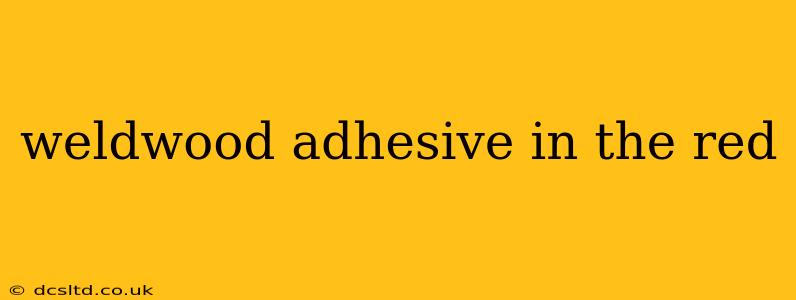Weldwood Contact Cement: The Iconic Red Can and Its Uses
Weldwood contact cement, instantly recognizable by its iconic red can, has been a staple in woodworking and DIY projects for generations. Its strong, durable bond makes it a go-to adhesive for a variety of applications, but understanding its properties and limitations is key to successful use. This guide delves into the specifics of Weldwood contact cement in the red can, exploring its uses, application techniques, and common questions.
What is Weldwood Contact Cement?
Weldwood contact cement, specifically the type in the red can, is a solvent-based adhesive known for its strong, permanent bond. Unlike wood glue which needs clamping, contact cement works by adhering two surfaces together through a chemical reaction rather than mechanical pressure. This makes it ideal for projects where clamping isn't feasible or where a gap-filling adhesive is not required. The "contact" part refers to the way it's applied – a thin layer to both surfaces, allowed to dry slightly (until tacky), and then firmly pressed together.
What Makes Weldwood Contact Cement Different?
Many contact cements exist, but Weldwood's red can formulation enjoys a long-standing reputation for reliability. Its formulation balances strong adhesion with a relatively easy application process, making it suitable for both experienced craftsmen and DIY enthusiasts. While other contact cements might offer specialized properties (like faster drying times or different viscosities), Weldwood often strikes a balance that caters to a wide range of projects.
What Can You Use Weldwood Contact Cement For?
Weldwood's versatility shines through in its diverse applications:
- Veneering: A classic use, bonding thin veneers to wood substrates is a perfect application for this adhesive. Its strong hold ensures a smooth, seamless finish.
- Laminates: Applying laminates to countertops, furniture, or other surfaces is efficiently achieved with Weldwood contact cement.
- Wood to Wood: Ideal for joining wood pieces where a strong, gap-free bond is needed.
- Fabric to Wood: It can securely bond fabric to wood, useful in upholstery and other crafts. (Note: Always test in an inconspicuous area first.)
- Metal to Wood: With proper surface preparation, Weldwood can bond metal to wood surfaces, though it might not be as ideal for all metal types.
- Plastic Laminates: Suitable for bonding some plastics to various surfaces, again, pre-testing is recommended.
Is Weldwood Contact Cement Waterproof?
While Weldwood contact cement creates a strong bond, its water resistance is not absolute. It offers good resistance to moisture, but prolonged or significant water exposure can compromise the bond's strength over time. For applications requiring complete waterproofing, consider using a specialized waterproof adhesive.
How Do You Clean Up Weldwood Contact Cement?
Solvent-based contact cement requires the appropriate cleanup. Mineral spirits or paint thinner are typically effective for cleaning up spills and residue. Always work in a well-ventilated area and wear appropriate safety gear, such as gloves and eye protection.
What are the Safety Precautions When Using Weldwood Contact Cement?
Weldwood contact cement, like other solvent-based adhesives, releases fumes. Always work in a well-ventilated area to minimize exposure. Wear gloves to protect your skin and eye protection to safeguard your eyes from splashes. Keep out of reach of children and pets. Refer to the manufacturer's safety data sheet (SDS) for comprehensive safety information.
Can Weldwood Contact Cement be Used on All Surfaces?
While versatile, Weldwood isn't universally compatible. Always test the adhesive on an inconspicuous area of the materials to ensure compatibility and proper adhesion before applying it to the entire project. Some plastics, porous materials, and certain treated woods might not adhere well.
Is Weldwood Contact Cement the Same as Wood Glue?
No, Weldwood contact cement and wood glue are distinct adhesives with different properties and uses. Wood glue is a water-based adhesive that requires clamping, providing a strong bond but often visible. Contact cement, on the other hand, requires no clamping and creates a virtually invisible bond. The choice depends entirely on the application.
By understanding the properties and applications of Weldwood contact cement in the red can, you can confidently tackle a range of woodworking and DIY projects. Remember to always prioritize safety and test the adhesive before starting any major project.
